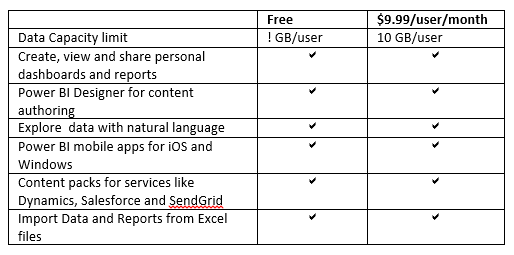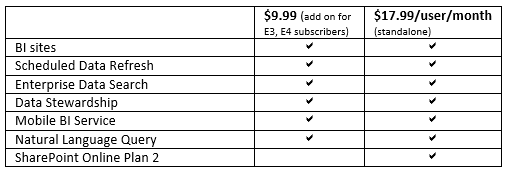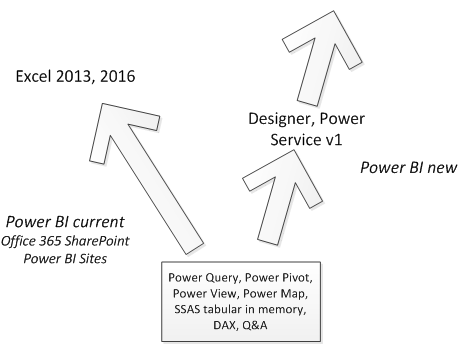Of all the great things about the new Power BI, there’s one thing not so lovable, and that is the confusion introduced by using the same term to mean yet another thing. If you go by the powerbi.com site, you get the impression “Power BI” refers specifically to Power BI Services plus Power BI Designer – the online service and the downloadable desktop authoring application.
If you’d never heard of Power BI before, this would seem straightforward enough. The two offerings combined let you create and publish reports. You author models using Power BI Designer. You use Query (aka Power Query) to get data from a bunch of sources, transform/edit it. You add relationships and calculated fields. Then you render nice visualizations and dashboards and voila, you have something you can serve up to Power BI Sites.
But most of us have heard of Power BI before. We may think of it as the incorporation of Power Pivot, Power Query and Power View into Excel, or we may think of it as SharePoint Office 365 Power BI sites. Or we may simply imagine that anything with the prefix “Power” published by Microsoft warrants inclusion.
So what does Power BI actually include?
The best site I’ve found for making sense of this is the Overview and Learning site. This narrative buckets Power BI into the “current experience,” – Power BI for Office 365 — and the “new experience,” Power BI Service and Power BI Designer. Here’s a little about both.
First, the new experience. This is what you learn about if you go to PowerBI.com. (Caveat: As most readers will know, Power BI Service is still in preview mode. So is Power BI Designer for that matter. What I write this week will be out of date by next). Power BI Service will be priced at $9.99/user/month (although an annual subscription is required). Presumably Designer, since it’s included in the service, will stay free. That pricing choice is really interesting when you look at how much power Microsoft is putting into the Designer tool. The late April release of the Designer lets you add measures, simplifies DAX-writing with a lot of smart intelli-sense, adds a bunch of new DAX measures, and allows for “bi-directional cross filtering.” (More on that last bit in a later blog).
You can see the new experience by seeing the video here. Or you can go to the tour page. Or you can download the preview and try it yourself.
Here’s a grid to make it easier (along with the pricing):
New Experience (Power BI Service + Designer)
The “current” experience centers on Office 365 SharePoint Power BI sites with Excel as the authoring tool. It doesn’t talk to Designer (.pbix) files. The sites themselves don’t have a dashboard feel to them. They feel more like a repository or publishing site only, and they feel more professional, more grown up. They render Power Views and Pivot Charts crisply, have nice Q&A functionality and, behind the scenes, offer data cataloging for enterprise data, which is powerful. You do have interactivity – you can filter on any given report – but you don’t have access to edit a report.
Current Experience (Office 365 SharePoint Power BI Sites + Excel)
Confusing Point #1: I’ve said both new and current have an authoring and a publishing component. In fact, the lines blur, especially in Power BI Service. You can actually author a lot there. You can edit existing reports and save them out. You can get data from sources directly. I haven’t tested the SSAS functionality, but presumably you can build reports directly from cubes. But wait a minute! You can do that from Designer too!
Same thing holds true to a lesser extent for “current.” In Office 365 SharePoint Power BI Sites you can’t “Get Data” in the same way you do it in Designer or Power BI Service, but you can use Q&A to mess around with the underlying data in any model posted up to the site. You can save those results as favorite Q&A. It’s limited, but you could still call it authoring.
Speculation on Confusing Point #1: Microsoft is keeping all options open. They don’t want to limit authoring capability to just Designer or Excel. Most users may never see Designer, so you need to give them something to explore and edit within Power BI Service. Plus Q&A is cool, you’ve already built it, now show it off. There’s no way to “mash-up” data on a Power BI Service site or an O365 Power BI Site. There’s no model-building in that sense. But that’s just today.
Confusing Point #2: The latest version of Designer (as of April 23rd or so) leapfrogs (some) of what you can do in Excel. You still can’t build a KPI or a hierarchy, see a diagram view, make a data table or generally get cozy with the model the same way you can do in Excel. But you can now write measures, and do bi-directional cross filtering, both of which are big. All of this in a freeapplication?
Speculation on Confusing Point #2: Microsoft’s hands are tied when it comes to rapid releasing of Excel versions. It’s simply too big and complex. But Power BI Service and Designer can be lots more nimble. So if they’ve built something cool, they want to start using it as soon as possible.
Confusing Point #3: Microsoft just bought DataZen.
Speculation on Confusing Point #3: .
Speculations on the big picture strategy
At the very great risk of crystal-balling Microsoft’s product strategy, a picture can help here. The left hand side is current, right side is new. They start at the same base, but they track different courses. You can’t release Excel quickly, as I said above. De-coupling the two lets you move fast. If the market wants Tableau-like access, ease and functionality, and if Microsoft has the dazzling analytics power of Power Pivot already nailed, better to not wait for Excel. There are lots of smart people invested in making sure Power Pivot based in Excel can live up to its promise as a rapid-prototyping solution, stand-alone analytics and warehousing engine. Rob Collie, Marco Russo, and Chris Webb come to mind. But they are a small percentage of the market, and there will be a niche for them. There’s a much bigger market that doesn’t need the power of Excel, and Microsoft can’t afford to keep them waiting.
Challenges
Design something with this much power and flexibility and then price it affordably and you are bound to steal market share. More importantly, to steal it back. But too many options – think the addition of DataZen – and not a clear direction of how they will all play together, and you run the risk of losing the integration advantage that Microsoft has. A challenge and trade off, yes, but one Microsoft seems willing to make. A word of advice: don’t wait too long before you do your next upgrade or download. The whole world may have changed by then.







